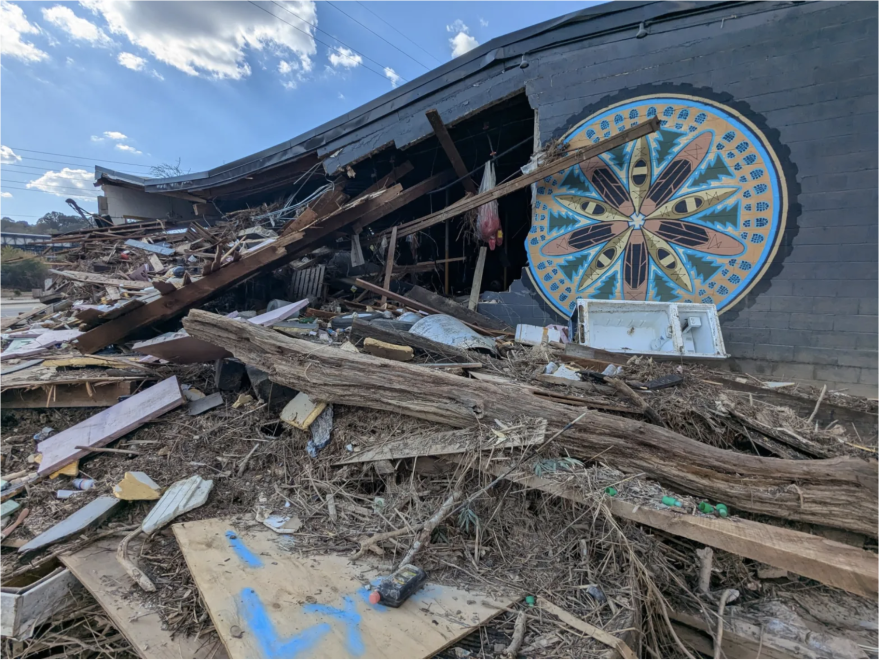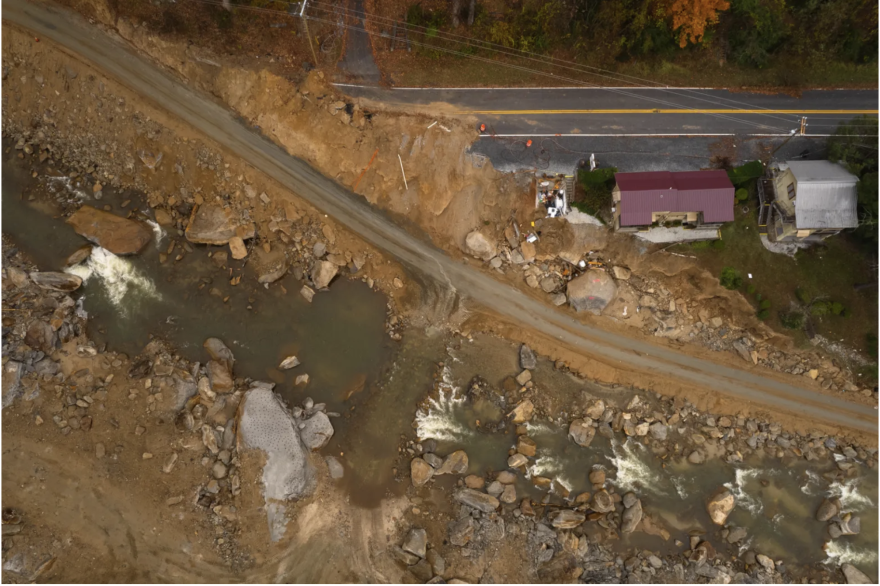One year ago, Tropical Storm Helene struck Western North Carolina. Rivers rejected their boundaries and trees slid from their mountains. Houses were uprooted from their foundations. Roads buckled under pressure. Lives were thrown from their course. The storm was cataclysmic. For 12 months, the region has focused on recovery, rebuilding and healing. One year after Helene, it has emerged transformed: battered, but in many respects stronger.
Small businesses like restaurants, tourist attractions and farms are bouncing back. Even so, in parts of the mountains, some are still struggling for basics such as food, housing and good health. One year after Helene, Western North Carolina’s recovery is still a work in progress — one that will determine not just whether the region returns to what it was, but what it becomes.
Reckoning with life, one year after Helene
One year after Helene, emotions run high. Physical reminders of the destruction remain, but the anniversary is a mental reminder, one that threatens to reopen certain scars.
“It is OK to feel like you are grieving a loss right now, because we did lose a lot,” David Jackson, president of the Boone Chamber of Commerce, told Carolina Public Press.
“We lost time. We lost people. We lost places. We have been so concerned and busy with restoring that not everybody has fully processed what happened. This one-year milestone will do that.”
Beside that grief, however, is hope. For Fabrice Julien, professor of health science at UNC-Asheville, balancing the two isn’t always easy.
“There’s this optimism, this feeling that something better could be just over the horizon,” Julien said. “In the background, though, that destruction remains. Behind every smile and every laugh, there’s a temporary moment of pause.”
This isn’t just any time of year in the North Carolina mountains. Helene struck at the most lucrative time for the region: the changing of the autumn leaves. This is when folks in the mountains make their “hibernating money,” as Jackson puts it. They did not get the chance to make that money last year.
Earning a living in a post-Helene NC
Employment has bounced back one year after the storm. Since January, the jobless rate in Buncombe County, home to Asheville, dropped from 6.8% — North Carolina’s highest at the time — down to 4.1% this summer. That’s a sign of a healthy economy returning.
“The health of the body before any injuries is really important to how you recover,” said Clark Duncan, director of the Asheville Chamber of Commerce. “Luckily, we were in robust economic health before the storm.”
Still, many small businesses in the mountains are on shaky ground one year later. They desperately need an injection of money but can’t stand to take out another loan.
In downtown Asheville, however, Meghan Rogers, director of the Asheville Independent Restaurant Coalition, sees reason for cautious optimism.
“I am feeling positive and hopeful, and I tend to be a glass-half-empty kind of girl,” Rogers told CPP.
“I have seen the gumption and the grit that our independent restaurants have shown to get reopened and to hire back. I’ve been overwhelmed at what it takes, what they’ve shown from day one through an entire year. Please come and see us.”

Some businesses and restaurants have even reopened in Asheville’s devastated River Arts District one year after Helene. But the continued health of the small business community relies heavily — perhaps too heavily — on the success of this fall.
“People are on a really thin margin right now,” Jackson said. “We need our fall to behave. We need sunny days and a lot of tourists.”
Visiting a post-Helene NC
The loss of tourism dollars over the past year has been devastating for the region. The immediate loss of the most valuable months was reinforced by the prolonged perception that the mountains were not open for business.
One year later, park visitation at Grandfather Mountain is down nearly 20% compared to this point in 2024.
The leisure and hospitality industry in Asheville is down 10% in terms of employment, Duncan said.
Rutherford County lost up to 50% of is average tourism revenue. The Rutherford County Tourism Development Authority had to lay off three employees, according to director Don Cason.
“It is pretty devastating,” Cason said. “Businesses have had to recover and survive without hardly any income.”
In the destruction, though, Rutherford County sees opportunity to reimagine itself. Before the storm, the upper portion of the Broad River was 100 feet wide. One year later, its banks are 600 feet apart, according to Cason. The county is planning to build hiking and biking trails in that extra space, hopefully attracting more visitors.

Businesses and local governments across the mountains are welcoming everyone back with open arms.
“We need you,” said Jeff Kaplan, director of Venture Asheville. “We are not going to make it back, to build a stronger, better Asheville in the future, without our visitor support. Everyone here benefits from visitors. Please come back.”
Unfortunately, visitor spending across the state has been slow this year so far, according to Marlise Taylor, director of tourism research at VisitNC. That’s due to an uncertain economy and fears of recession — many are closing their pocketbooks and staying put.
Living in a post-storm Western NC
Those economic uncertainties are plaguing folks in the mountains as well one year after Helene. A significant portion of Western North Carolina's population is still struggling to meet basic needs.
Access to food and shelter was already strained in parts of the North Carolina mountains. The storm deepened those insecurities. In communities like Spruce Pine and Swannanoa, grocery stores have not yet reopened. Food banks and housing services are serving record numbers of people.
MANNA Foodbank is seeing more than 170,000 visits per month across its 16-county service area. That’s the most the foodbank has served in its 42-year history.
“This is due to the storm, as well as the rising cost of goods and the stagnant wages in our region,” Micah Chrisman, spokesperson for MANNA, told CPP.

“People are having to work multiple jobs to make ends meet. They’re choosing between buying their medicine or paying for groceries or paying rent. The cost of living is just too high. Businesses in our area may be open, but they are not able to pay livable wages. Rich and poor people are coming to our pantries.”
The increased demand isn't just from people who lost jobs or homes in the storm. One year later, Sarah Banks, health director for Haywood County, describes seeing teachers, nurses and middle-income families accessing county services for the first time.
In Spruce Pine, where the town’s only dedicated grocery store remains closed due to catastrophic flooding, traffic at the local food bank is staggering.
At Mitchell County Shepherd’s Staff, director Starli McDowell says she served 1,979 households in August. The population of Spruce Pine is only 2,192.
McDowell says Shepherd’s Staff is still giving out clean water just as fast as they can get it, and helping folks pay their bills, fix their wells and repair their homes.
Those with homes to repair count themselves lucky. The housing crisis, which already plagued Western North Carolina, continues to fester one year after the storm.
Evictions are on the rise, according to David Bartholomew, an attorney at Pisgah Legal Services. Rents briefly declined immediately after the storm but quickly returned to pre-Helene levels and have remained elevated. Activists were lobbying for an eviction moratorium in the aftermath of the storm, but it never materialized. Bartholomew says as the months pass, landlords and property managers are becoming less inclined to work with assistance programs.
Last week, 100 people in danger of eviction were lined up at the door of Grace Covenant, an Asheville church that has dedicated itself to rent assistance. On that day, Grace Covenant dedicated $50,000 of its funding and $15,000 from the Long-Term Recovery Group to stop evictions, according to pastor Marcia Shoop.
“There are a lot of people on the edge,” Shoop told CPP. “And there are so many kinds of edges people can fall off.”
One year after Helene, street homelessness has increased measurably in Asheville. According to Asheville homeless agency Homeward Bound, point-in-time count data from January 2025 showed 328 unsheltered individuals in the Asheville area, up from 219 in 2024 — an increase of 50%.
Meanwhile, the number of people in transitional housing decreased from 250 to 157. Temporary solutions are running out faster than permanent ones can be found.
Many of Homeward Bound’s clients navigated the everchanging deadlines and extensions for FEMA hotel and temporary shelter vouchers that have now expired.
“That created a lot of instability for our clients, many of whom we are still in the process of rehousing,” said Ansley Carter, spokesperson for Homeward Bound. “A year later, we still see people at the lowest income level struggling to move from those temporary situations into stable housing.”
A year of contradictions
The economic recovery in the mountains defies easy conclusions.
In many ways, the region has bounced back remarkably. Unemployment rates have returned to healthier levels. Most businesses have reopened. Infrastructure is largely restored. The mountains bill themselves as open for business.
But those facts obscure a complex reality. At the one-year mark, much remains to worry about. Food banks are serving more people than ever before. Street homelessness has increased 50% in Asheville. Teachers and nurses are relying on assistance programs. In Spruce Pine, nearly as many households visited the food pantry as live in the town.
Still, hope abounds.
“This is going to sound like a cliché, but it isn’t,” John Mitchell, Henderson County manager, told CPP.
“The residents of this county, the folks who work in emergency management, the churches, everyone else: they have looked after our neighbors. They’ve done the hard work to get this community back on its feet.
“There is still suffering. There is no doubt about that. But this recovery has been profound.”
This article first appeared on Carolina Public Press and is republished here under a Creative Commons Attribution-NoDerivatives 4.0 International License.






